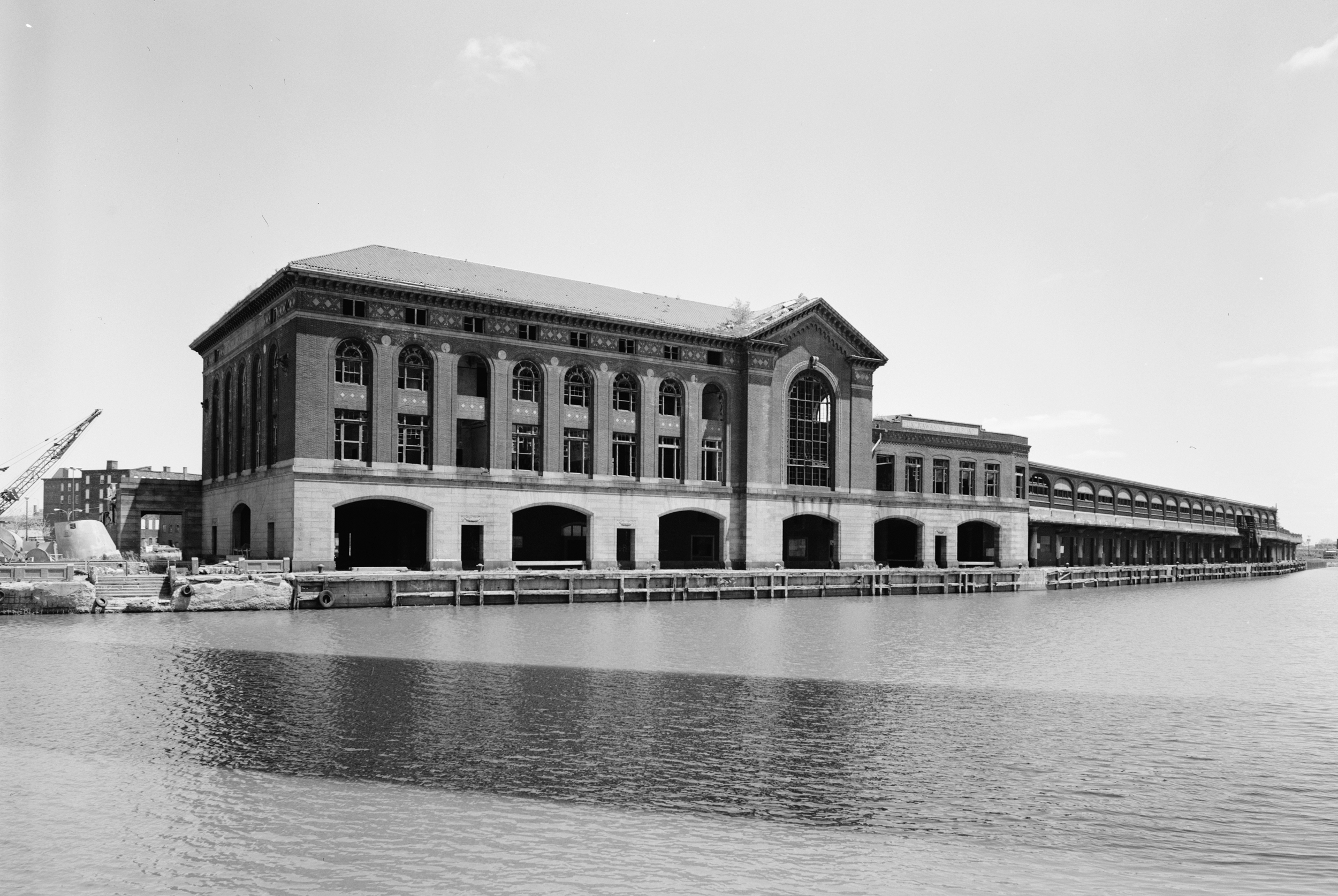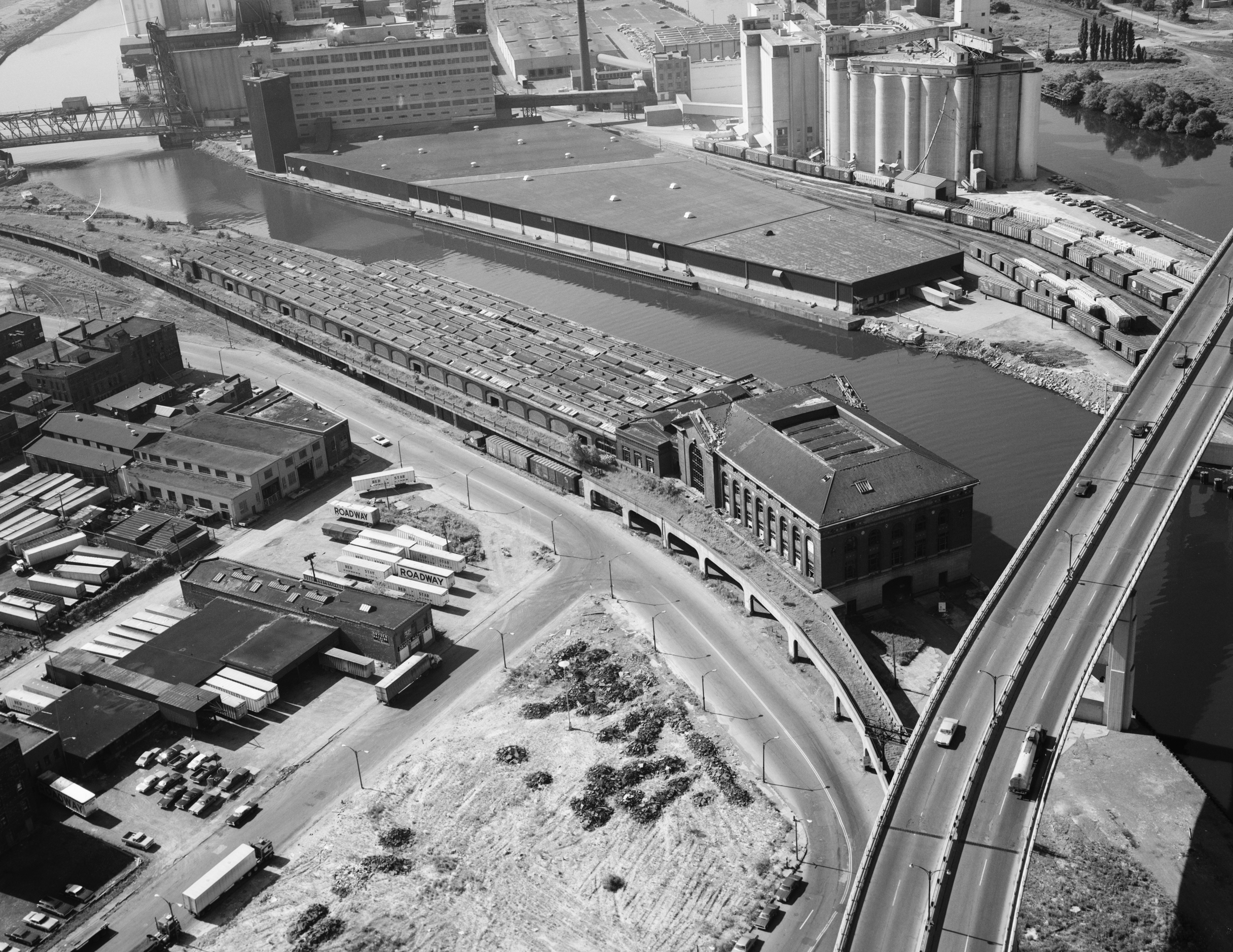Lackawanna Terminal, DL&W's Buffalo Station
Last revised: September 10, 2024
By: Adam Burns
Lackawanna Terminal in Buffalo, New York, is a historic train station that was built in 1917 by the Delaware, Lackawanna and Western Railroad.
The Beaux-Arts style building, designed by Kenneth M. Murchison, was a bustling transportation hub until it ceased operations in 1962.
Despite being recognized as a historically significant historic landmark, no preservation groups stepped in to save the headhouse, which was demolished in 1979. Today, the remaining train shed and raised platforms are part of the NFTA Rail Maintenance Yard. In addition, recent efforts have been made to restore and repurpose the remaining building.
 A view of the Lackawanna Terminal headhouse and train shed as seen from across the Buffalo River, circa 1971 after the facility had closed.
A view of the Lackawanna Terminal headhouse and train shed as seen from across the Buffalo River, circa 1971 after the facility had closed.Delaware, Lackawanna & Western
Lackawanna Terminal in Buffalo, New York, stands as an enduring symbol of the city's rich history and its deep-rooted connection to the expansive American railway system. Constructed for the Delaware Lackawanna and Western Railroad, the station represented a beacon of progress and prosperity in its heyday.
Kenneth M. Murchison
The man behind the architectural masterpiece that was Lackawanna Terminal was esteemed architect Kenneth M. Murchison. Murchison was renowned for his distinctive designs, particularly in the realm of transportation architecture, comprising several notable railway stations across the United States.
At A Glance
Lackawanna Terminal officially opened its doors to the public on October 5, 1917, marking a new chapter in Buffalo’s transportation history. The new hub served as a vibrant nucleus of passenger travel and commercial activity, spotlighting Buffalo's strategic significance in the regional railway network.
Surprisingly, despite its grandeur and significance, exact records related to the total cost of building Lackawanna Terminal remain elusive. However, based on figures from similar projects of the era, it can be inferred that the cost would have been a substantial sum, reflective of the extensive infrastructure and careful craftsmanship involved in the station's construction.
Architectural Design
The monumental Lackawanna Terminal was designed in the grand Beaux-Arts architectural style. This style, popular in the Gilded Age, is known for its classical forms, richly ornamented facades, and monumental proportions. It represented a perfect fusion of modern functionality and aesthetic opulence, attracting visitors with its visually stunning design.
The muscular form of Lackawanna Terminal was constructed using buff-colored brick and terra cotta. Not only mentioned for their aesthetic appeal, these materials also offered durable, weather-resistant qualities, ensuring the terminal’s longevity amid the harsh weather conditions faced in Buffalo.
Lackawanna Terminal was situated at the foot of Main Street, near the shores of Lake Erie in Buffalo, New York. Its strategic placement facilitated easy access for city residents and linked Buffalo to significant railway routes, reinforcing its role as a vital transportation hub.
The facility was originally built as a through terminal. However, the completion of the Buffalo Skyway in 1955 obliterated the northern connecting track
The terminal was expansive in design, incorporating a total of seven tracks beneath the train shed and one through track, all of which was situated on elevated platforms.
This significant number is reflective of the large quantities of passengers and goods the terminal was designed to accommodate, testament to its strategic importance for the Delaware Lackawanna and Western.
The building was a three-story brownstone structure featuring waiting rooms on the first two floors, connected by a grand double staircase. The ground floor housed the ticket office and seating benches.
The headhouse/station was three stories. The second floor had expansive accommodation for 200 people, a women's parlor furnished with brown wicker furniture, a rug and writing desk, as well as a smoking room.
The entrace to the train concourse was located at the middle of the east side of the waiting room and nearby were a newsstand, booths for telegraph and parcel services, and a restaurant.
The mezzanine floor was delegated to railroad employees, a waiting room for immigrants, and a business mail room, while the third floor housed various offices, such as the superintendent's and train dispatcher's offices.
At its peak, Lackawanna Terminal served an impressive number of trains. It handled all of the DL&W's notable intercity trains, cementing Buffalo’s role as a critical transportation pivot in New York state. These included names like (as of 1952):
- Phoebe Snow (flagship train)
- The Twilight
- The Westerner
- The Owl
- The Pocono Express
- The New Yorker
- New York Mail
- Merchants Express
While the terminal primarily served Lackawanna trains it was also served by the Buffalo, Rochester & Pittsburgh (acquired by the Baltimore & Ohio in 1932); Pere Marquette Railway (until 1932), Nickel Plate Road, and the Wabash.
However, the terminal's vibrant epoch didn't last forever. Its prominence slowly declined with the advent of automobiles and airlines, gradually reducing the station's operational significance. The decreasing passenger numbers coupled with the cost of its upkeep led to a cessation of services by the mid-20th century.
The terminal faced a significant blow when the headhouse was demolished in 1979, following years of decreased use and neglect. This loss marked the end of an era for the once bustling hub, leaving a palpable absence in Buffalo's architectural landscape.
Despite the headhouse's demolition, the train shed remains intact. Today, it serves a different function, having been repurposed into the Metro Rail Maintenance Yard. This adaptation has facilitated the preservation of a part of Buffalo's rich railway heritage while catering to the evolving transportation needs of the city.
Legacy
The Lackawanna Terminal, in its time, personified the vibrance and dynamism of Buffalo. Its architectural grandeur, coupled with its critical function as a hub in the Delaware Lackawanna and Western Railroad network, underscores its importance in the history of Buffalo and American rail transportation.
The Beaux-Arts design of the terminal, courtesy of architect Murchison, was a confluence of old-world charm and new-world pragmatism. Its buff-colored brick and terra cotta façade, grand arches, and detailed ornamentation enveloped the station with an air of sophistication and substance.
The Delaware Lackawanna and Western was a significant player in America's rail transportation landscape, particularly in the northeastern states. The Buffalo terminal represented a critical node in its expansive railway network as the western end of its network, which stretched as far east as Hoboken, New Jersey.
The tracks that sprawled out from Lackawanna Terminal, extending its reach to different parts of New York state and beyond, highlight the station's importance. The terminal was more than just a stand-alone structure; it played a crucial role in the intricate railway grid that bridged various American cities.
Despite the changes over time, the Lackawanna Terminal's legacy continues to linger in Buffalo's memories. The remaining train shed, now serving as the Metro Rail Maintenance Yard, is a nod to the city's railway past, even as it gears up for the transportation trends of the future.
As we delve deeper into the history of Lackawanna Terminal Buffalo, it becomes clear that its tale is not merely one of bricks and mortar. It’s a tale about Buffalo’s growth, the rise and fall of railroads, and a testament to the resilient spirit of cities that dust off the vestiges of the past while embracing the future.
Buffalo’s Lackawanna Terminal was much more than just another railway station. It was an integral part of the Delaware Lackawanna and Western, a bustling hub for commerce and travel, and, above all, a magnificent edifice that gave Buffalo a distinct identity in the elaborate tapestry of the American railway landscape.
While the specifics about the building cost and the station's peak passenger numbers may be missing, our understanding of Lackawanna Terminal is far from incomplete. The available records together with the surviving train shed provide invaluable insights into its history, persona, and enduring legacy.
The Beaux-Arts style of Lackawanna Terminal, a blend of neoclassical forms and contemporary methods, was emblematic of the architectural idiom of the time. It projected an aura of power, elegance, and progress, fitting for a terminal conceived to service a dynamic and progressive 20th-century Buffalo.
Buff-colored brick and terra cotta, the primary construction materials for the Lackawanna Terminal, echoed typical Beaux-Arts architectural preferences. Beyond their aesthetic values, these materials' durability speaks volumes about the station's robustness, conceived to withstand the test of time and nature's elements.
Located at the foot of Main Street, Lackawanna Terminal's geographical placement was no random selection. It was chosen meticulously, guaranteeing easy connectivity with the city, and playing a crucial role in fortifying Buffalo's significant position in New York state's transportation map.
Lackawanna Terminal's decline and the eventual demolition of its headhouse reflect the structural shifts within the broader transportation industry. However, it also proffers a lesson in resilience and evolution, as evidenced by the repurposing of the remaining train shed into a maintenance yard for metro rail.
The succeeding chapters in the Lackawanna Terminal’s tale embrace the ethos of practicality and perseverance. The surviving train shed's adaptation as a Metro Rail Maintenance Yard illustrates a strategic transition, encapsulating the marriage of a historic remnant with a relevant utility.
The gradual decline of Lackawanna Terminal Buffalo resonates with the overarching historical context shaped by evolving technologies and shifting preferences. As airplanes and cars emerged as viable alternatives for long-distance travel, the station’s deceleration reflected a broader narrative of change.
In 1960, the Delaware, Lackawanna & Western and Erie railroads merged to form the new Erie Lackawanna Railway system. The new EL subsequently abandoned passenger service to the facility in late 1962, switching to a small station at 515 Babcock Street.
The story of Lackawanna Terminal Buffalo is one of glory, transformation, and resilience. Its peak years were punctuated by the hustle and bustle of commerce, the steady rhythm of arriving and departing trains, and the hum of a city on the move. Today, its remaining train shed stands as a silent testament to a bygone era, yet bristling with reminders of its undying relevance.
Ultimately, Lackawanna Terminal Buffalo, in its distinctive architecture and transformative journey, conveys the spirit of a city and a period in history. It teaches the value of adaptability, the potency of vision, and the resilience inherent in repurposing the past to service the future.
As such, the Lackawanna Terminal's tale becomes an essential reference for students of architecture, history, and anyone interested in understanding the evolution of transportation hubs in American cities.
Today
In 1977, the Niagara Frontier Transportation Authority (NFTA) chose the former terminal complex as the maintenance and storage site for the Buffalo Light Rail Rapid Transit (LRRT) system due to its potential for covered storage in a rehabilitated train shed.
However, the plan required the demolition of the ticketing and terminal buildings at the DL&W site to make way for a complex ladder track switching area. This area would guide trains from the mainline alignment to individual storage bays in the train sheds.
In 1979, Conrail, then-owner of the terminal, sold the 8.1 acre site to the NFTA, which subsequently converted it into the current yard complex.
Contents
Recent Articles
-
Maine Railroad Museums: A Complete Guide
Apr 21, 25 12:58 PM
Maine's railroads have long been associated with logging and agriculture. Today, a number of museums honoring this heritage can be found throughout the state. -
Kentucky Railroad Museums: A Complete Guide
Apr 20, 25 03:17 PM
Kentucky has long contained a mix of important through main lines and rich bituminous coal seams for the railroad industry. Today, a handful of museums can be found across the state. -
Kansas Railroad Museums: A Complete Guide
Apr 20, 25 02:58 PM
Located within the Heartland, Kansas has always been an important agricultural state for railroads. A number of museums can be found throughout the state.
